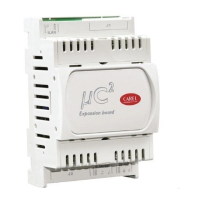- Funzione seconda pompa
H21: Questo parametro definisce come l’uscita dedicata alla seconda
pompa debba essere gestita.
H21= 0: la seconda pompa viene disabilitata.
H21= 1: la seconda pompa serve solo da Backup.
Se interviene il flussostato che attiva l’allarme, le pompe
vengono scambiate:
• se l’allarme rientra, viene generato un avviso a display
e viene eccitato il relè di avviso, mentre l’unità continua
a funzionare con la pompa di Backup.
Al prossimo allarme le pompe verranno ruotate.
• se l’allarme rimane attivo anche con la seconda
pompa, dopo il tempo P01, viene generato l’allarme
generale e l’unità viene spenta.
H21= 2: la seconda pompa rappresenta una pompa di Backup.
Le 2 pompe non sono mai usate contemporaneamente
ma ogni 24 ore vengono alternate.
In caso di allarme flussostato, vale la stessa logica per
l’impostazione 1. Dopo un scambio dovuto all’allarme
flusso, il timer delle 24 ore viene azzerato.
H21= 3: la seconda pompa viene utilizzata come ON/OFF con la
stessa modalità del ventilatore di condensazione (che in
questo caso non è presente) in modalità ON/OFF con gli
stessi set (di fatto in questo caso la pompa sostituisce il
ventilatore compreso il simbolo).
H21= 4: la seconda pompa viene utilizzata per la condensazione
ma è sempre accesa. Il questo caso il simbolo della
pompa non viene gestito.
Nota: In caso di allarme flusso a ripristino automatico si effettuano 10
tentativi di riavvio pompa ogni 90 s, per il tempo massimo di P02; dopo
10 tentativi l’allarme diventa a ripristino manuale. Con la seconda
pompa il tentativo consiste nello scambio della pompa in funzione, con
la stessa logica.
- Disabilitazione caricamento default
H22: Questo parametro se posto a 1 disabilita la possibilità di ripristinare
i parametri di default tramite il tasto Prg premuto al ripristino tensione.
• Impostazione allarmi: parametri (P*)
- Ritardo allarme flussostato all'avviamento pompa
P01: Stabilisce un ritardo nel riconoscimento dell'allarme del flussostato
all'avviamento della pompa (si attende che la portata arrivi a regime).
In caso di allarme i compressori devono essere spenti
immediatamente, ignorando le tempistiche.
- Ritardo allarme flussostato a regime
P02: Stabilisce un ritardo nel riconoscimento dell'allarme del flussostato
a regime, per filtrare eventuali variazioni di portata o bolle d'aria
presenti nel circuito dell'acqua. In caso di allarme i compressori
devono essere spenti immediatamente, ignorando le tempistiche.
- Ritardo allarme bassa pressione alla partenza compressore
P03: Stabilisce un ritardo nel riconoscimento dell'allarme di bassa
pressione alla partenza del compressore per permettere il
raggiungimento di una situazione di regime. Questo ritardo viene
rispettato anche all'inversione della valvola a 4 vie nel circuito del gas.
- Ripristino allarmi
P05: Abilita il ripristino automatico per tutti quegli allarmi che sono
normalmente a ripristino manuale (alta pressione, bassa pressione,
flussostato/antigelo) secondo la tabella di seguito riportata:
P05= 0: alta pressione, bassa pressione e antigelo
(default) (bassa temperatura) a ripristino manuale
P05= 1: tutti gli allarmi a ripristino automatico
P05= 2: alta pressione e antigelo (bassa temperatura) in
manuale, bassa pressione in automatico
P05= 3: alta pressione in manuale, bassa pressione e antigelo
(bassa temperatura) in automatico
- Function of the second pump
H21: This parameter defines how the output dedicated to the second
pump must be managed.
H21= 0: 0, the second pump is disabled.
H21= 1: 1, the second pump is used only as a backup.
If the flow switch and corresponding alarm are activated,
the pumps are switched over:
• if the alarm passes, a warning is shown on the display
and the warning relay is activated, while the unit
continues to operate with the Backup pump. When the
next alarm is activated the pumps will be switched over.
• if the alarm remains active even with the second pump
on for longer than the time set for P1, the generic alarm
is generated and the unit is switched OFF.
H21= 2: the second pump represents a backup pump.
The two pumps are never used at the same time but
each 24 hours, are switched over. In the event of flow
alarms, the logic is the same as for setting 1.
After being switched over due to the flow alarm, the
24-hour timer is set to zero.
H21= 3: the second pump is used as an ON/OFF device in the same
way as the condenser fan (which in this case is not
present), in ON/OFF mode, with the same settings (in
fact in this case the pump replaces the fan, including the
symbol).
H21= 4: the second pump is used for the condenser but is always
ON. In this case the pump symbol is not managed.
Note: In the event of flow alarms with automatic reset, 10 attempts are
made to restart the pump every 90 seconds, for a maximum time of
P02; after the 10 attempts, the alarm becomes manual reset. With the
second pump, the attempt consists in switching over the pump that is
on, with the same logic.
- Disable load default values
H22: If this parameter is set to 1, it disables the possibility of restoring
the default parameters using the PRG button at power ON.
• Alarm settings: parameters (P*)
- Flow switch alarm delay when starting pump
P01: Establishes a delay in the recognition of the flow switch alarm
when starting the pump (this allows the flow-rate to stabilise). In
the event of alarms, the compressors are stopped immediately,
ignoring the times.
- Flow switch alarm delay in steady operation
P02: Establishes a delay in the recognition of the flow switch alarm in
steady operation, so as to filter any variations in flow-rate or air
bubbles present in the water circuit. In the event of alarms, the
compressors are stopped immediately, ignoring the times.
- Low pressure alarm delay at compressor start
P03: Establishes a delay in the recognition of the low pressure alarm
when the compressor starts, so as to allow stable operating
conditions to be reached. This delay is also counted when
reversing the 4-way valve in the refrigerant circuit.
- Alarm reset
P05: Enables automatic reset for all those alarms that normally feature
manual reset (high pressure, low pressure, flow switch /
antifreeze) as per the following table:
P05= 0: high pressure, low pressure and antifreeze (low
(default) temperature) with manual reset
P05= 1: all the alarms with automatic reset
P05= 2: high pressure and antifreeze (low temperature) manual,
low pressure automatic
P05= 3: high pressure manual, low pressure and antifreeze (low
temperature) automatic
56
µC
2
- cod. +030220420 - rel. 2.0 - 18.10.04

